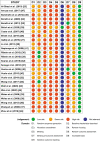The Effects of Cannabinoids on Pro- and Anti-Inflammatory Cytokines: A Systematic Review of In Vivo Studies
- PMID: 33998900
- PMCID: PMC8266561
- DOI: 10.1089/can.2020.0105
The Effects of Cannabinoids on Pro- and Anti-Inflammatory Cytokines: A Systematic Review of In Vivo Studies
Abstract
Introduction: Some cannabinoids have been identified as anti-inflammatory agents; however, their potential therapeutic or prophylactic applications remain controversial. The aim of this systematic review was to provide a timely and comprehensive insight into cannabinoid-mediated pro- and anti-inflammatory cytokine responses in preclinical in vivo studies. Methods and Materials: A systematic search was conducted using PubMed, Web of Science, EMBASE, and Scopus. Eligible studies where cannabinoids had been evaluated for their effect on inflammation in animal models were included in the analysis. Data were extracted from 26 of 4247 eligible full text articles, and risk of bias was assessed using the SYstematic Review Center for Laboratory animal Experimentation (SYRCLE) tool. Studies examined cannabidiol (CBD; n=20); cannabigerol (CBG; n=1); delta 9-tetrahydrocannabinol (THC; n=2); THC and CBD separately (n=1); and THC and CBD in combination (n=2). Results: Tumor necrosis factor alpha, interleukin (IL)-1β, IL-6, and interferon gamma were the most commonly studied pro-inflammatory cytokines and their levels were consistently reduced after treatment with CBD, CBG, or CBD+THC, but not with THC alone. The association between cannabinoid-induced anti-inflammatory response and disease severity was examined. In 22 studies where CBD, CBG, or CBD in combination with THC were administered, a reduction in the levels of at least one inflammatory cytokine was observed, and in 24 studies, some improvements in disease or disability were apparent. THC alone did not reduce pro-inflammatory cytokine levels (n=3), but resulted in improvements in neuropathic pain in one study. Conclusions: This review shows that CBD, CBG, and CBD+THC combination exert a predominantly anti-inflammatory effect in vivo, whereas THC alone does not reduce pro-inflammatory or increase anti-inflammatory cytokines. It is anticipated that this information could be used to inform human clinical trials of cannabinoids, focusing on CBD and CBG to reduce inflammation across a range of pathophysiological processes.
Keywords: CBD; THC; anti-inflammatory; cannabinoids; cannabis; cytokines; inflammation; systematic review.
Conflict of interest statement
G.Z.S. and L.S.D. are part of the NICM Health Research Institute at Western Sydney University. As a medical research institute, NICM receives research grants and donations from foundations, universities, government agencies, individuals and industry. Sponsors and donors provide untied funding for work to advance the vision and mission of the Institute. The project that is the subject of this article was not undertaken as part of a contractual relationship with any organization other than the funding declared hereunder. It should also be noted that NICM conducts clinical trials relevant to this topic area, for which further details can be provided on request. G.Z.S. has received funding from Australian Natural Therapeutics Group to conduct investigator-initiated cannabis research; this company did not have any role in the conduct of this research.
Figures



References
-
- Li H-L. An archaeological and historical account of cannabis in China. Econ Bot. 1973;28:437–448
-
- Mechoulam R. The pharmacohistory of Cannabis sativa. Cannabinoids as Therapeutic Agents. Chapman and Hall/CRC: Boca Raton, FL, 2019
-
- Iversen LL. The science of marijuana. Oxford University Press: Oxford, UK, 2001
Publication types
MeSH terms
Substances
LinkOut - more resources
Full Text Sources
Other Literature Sources
Research Materials
Miscellaneous

